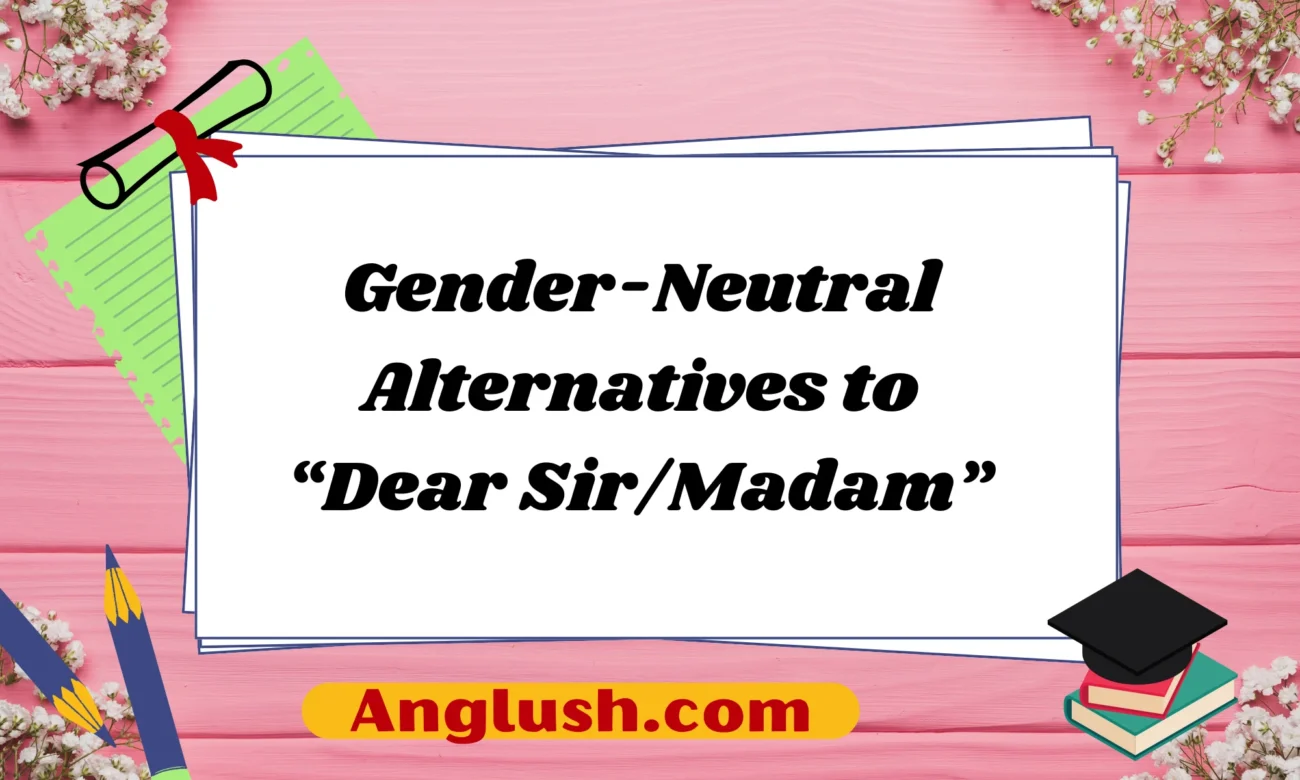Introduction
For years, the phrase “Dear Sir/Madam” has been a standard salutation in formal letters and emails when the recipient’s name is unknown. However, as workplaces and professional settings move toward more inclusive language, many people seek gender-neutral alternatives that feel more modern, warm, and respectful.
In this article, we’ll explore 26+ gender-neutral alternatives to “Dear Sir/Madam,” categorized by tone and context. Whether you’re writing a business email, a job application, or a customer service message, this guide will help you find the perfect greeting.
Why Use Gender-Neutral Alternatives?
Using inclusive language is essential for fostering respect, professionalism, and approachability in communication. Here’s why you should consider switching from “Dear Sir/Madam” to something more inclusive:
✔ Avoids Gender Assumptions – You don’t risk misgendering or alienating anyone.
✔ Feels More Personal – Modern alternatives can make your message feel more natural and engaging.
✔ Better for Business – Inclusive communication fosters a welcoming environment in professional settings.
✔ Preferred by Many Organizations – Companies and institutions encourage gender-neutral language to promote diversity and inclusion.
Now, let’s dive into the best alternatives you can use!
Professional and Formal Alternatives
These options are best for corporate, legal, academic, and formal business settings where professionalism is key.
1. Dear [Job Title]
Example: “Dear Hiring Manager”
This is ideal when writing a job application or an inquiry about a position. It’s direct and professional.
2. Dear [Department Name]
Example: “Dear Customer Service Team”
Using a department name works well for customer support or inquiries when you don’t know the recipient’s name.
3. To Whom It May Concern
This is a classic but neutral phrase often used for letters of recommendation, legal matters, and official documents. However, it can feel impersonal, so use it only when necessary.
4. Dear [Company Name] Team
Example: “Dear OpenAI Team”
Great for addressing an entire company or team when writing a business proposal or collaboration request.
5. Dear [Specific Role or Function]
Example: “Dear Admissions Office”
This works well when reaching out to institutions like universities, government offices, or large organizations.
6. Dear [Committee Name]
Example: “Dear Scholarship Committee”
A perfect option for applications, proposals, and formal submissions.
7. Dear Valued Customer/Client
Best for business emails and customer service messages where personalization is not possible.
Neutral and Friendly Alternatives
If you want to maintain a professional yet friendly tone, consider these options.
8. Hello [Department/Team]
Example: “Hello Marketing Team”
This strikes a balance between formality and warmth, making it suitable for business emails.
9. Dear Colleague(s)
If you’re addressing peers or work associates, this is a great gender-neutral option.
10. Hi [Company Name]
Example: “Hi LinkedIn Support”
Casual yet professional, this is ideal for inquiries to customer support or business teams.
11. Attention: [Job Title/Department]
Example: “Attention: HR Department”
This format is straightforward and often used in cover letters and official requests.
12. Esteemed Team at [Company Name]
Example: “Esteemed Team at Google”
A more polished option for business emails and formal proposals.
Casual and Polite Alternatives
For less formal settings, networking, or friendly business interactions, these greetings work well.
13. Hi There
A casual yet respectful way to open an email when you’re unsure of the recipient’s name.
14. Greetings
A simple and neutral opening that works in various professional and friendly contexts.
15. Hello Everyone
Perfect when addressing a group of people in a company or department.
16. Good Morning / Good Afternoon
Example: “Good Morning, I hope you’re doing well.”
This adds warmth to your email and works in both professional and casual emails.
17. Dear Guest
Ideal for hospitality, tourism, and event-related communications when addressing attendees.
18. Hey Team
A relaxed yet professional way to address a group.
Alternatives for Customer Service and Support Emails
These options are great for customer inquiries, service requests, and support emails.
19. Dear Valued Customer
Shows appreciation while keeping the tone professional.
20. Hello [First Name] (If Available)
Personalization always makes emails more engaging. If you have the recipient’s name, use it!
21. Dear Account Holder
Good for financial institutions or service-based businesses.
22. Dear Community Member
Great for newsletters, non-profits, and membership-based organizations.
23. Hello [Service/Product] User
Example: “Hello OpenAI User”
This works for subscription services and software companies.
24. Welcome!
A warm greeting, especially for onboarding emails.
11 Texting Examples for Emails and Messages
Here are quick and user-friendly email greeting examples optimized for readability:
1️⃣ “Hello Hiring Manager, I’m excited to apply for…”
2️⃣ “Dear Customer Service Team, I need assistance with…”
3️⃣ “Good Morning, I’d like to follow up on…”
4️⃣ “Hey Team, just checking in about…”
5️⃣ “Dear Support, I encountered an issue with…”
6️⃣ “Hello [First Name], I wanted to ask about…”
7️⃣ “Attention: HR Department, I have a question regarding…”
8️⃣ “Greetings, I’m reaching out regarding…”
9️⃣ “Dear Admissions Office, I need clarification on…”
🔟 “Hello Marketing Team, could you share insights on…”
1️⃣1️⃣ “Dear Esteemed Team at [Company Name], I’m interested in…”
How to Choose the Right Alternative
🔹 Consider the Context – A formal email may require “Dear Hiring Manager,” while a casual one can start with “Hi Team.”
🔹 Know Your Audience – A university application should be more formal than a quick inquiry email.
🔹 Personalization Matters – If you have the recipient’s name, use it for a warmer tone.
Final Thoughts
Moving away from “Dear Sir/Madam” to gender-neutral alternatives helps create more inclusive, respectful, and engaging communication. Whether you’re applying for a job, contacting customer service, or reaching out for business, there’s always a suitable alternative.
By choosing the right greeting, you ensure professionalism and warmth while making everyone feel valued. So, next time you draft an email, try one of these 26+ alternatives!

